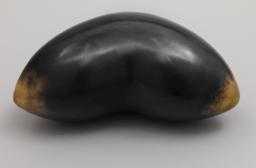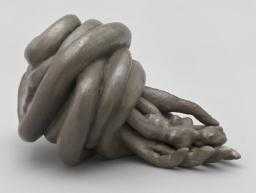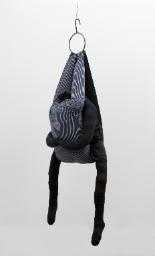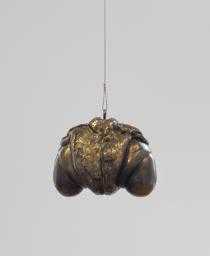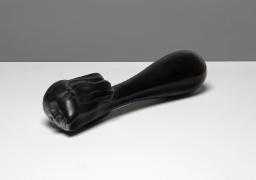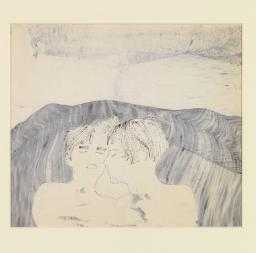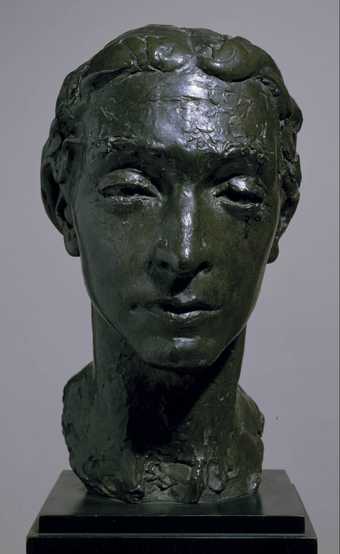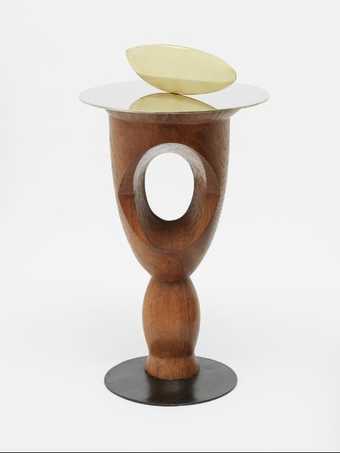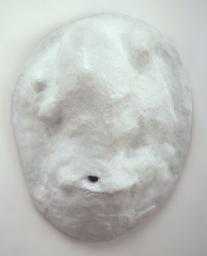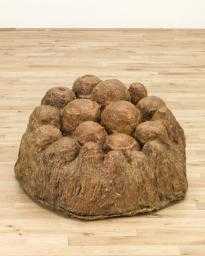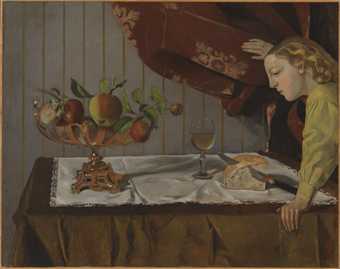
Not on display
- Artist
- Louise Bourgeois 1911–2010
- Medium
- Wood and copper
- Dimensions
- Displayed: 1735 × 270 × 80 mm
- Collection
- Lent by the Tate Americas Foundation, courtesy The Easton Foundation in honour of Frances Morris 2016
On long term loan - Reference
- L03806
Summary
KNIFE COUPLE 1949 is a carved wood sculpture consisting of two tall, pointed abstract figures on a small, square stainless steel base which stands directly on the floor. The artist later cast the work in bronze in an edition of six (all in private collections). The work is one of approximately eighty figure sculptures made between 1945 and 1955 which Bourgeois later generically termed ‘Personages’.
Bourgeois first showed the Personages in a group of seventeen figures that were installed at the Peridot Gallery in New York in 1949. KNIFE COUPLE was included in an exhibition at the same gallery the following year. Carved wooden figures were made to human scale and placed directly on the floor in groups around the gallery to create a kind of social space, which retrospectively may be seen as an early type of installation work. While she was making her Personages, Bourgeois used a space on the rooftop of her New York apartment building as a makeshift studio and photographs show her surrounded by the portable wooden figures both indoors and out on the roof.
Critics of the Peridot Gallery exhibitions described the Personages as primitivist, referring to their appearance as well as their totemic and fetishistic aspects. The reference to primitivism in these early sculptures is unsurprising given the influence on Bourgeois of surrealism and the fact that her American husband, Robert Goldwater, was a specialist in African art and later the first director of the Museum of Primitive Art in New York. A decade after leaving France in 1938 to live with her husband in New York, Bourgeois made sculptures that she described as a kind of ‘exorcism’ of her past, recreating figures that stood in for the family members she left behind during the war and using dynamic production methods such as carving, hammering and honing to give expression and form to her emotions. The art historian Mignon Nixon has described the Personages as ‘the work of mourning’ (Nixon 2005, p.119). Bourgeois herself explained, ‘I was missing certain people that I had left behind. It was a tangible way of re-creating a missed past. The figures were presences that needed the room, the six sides of the cube … It was the reconstruction of the past’ (quoted in Nixon 2005, p.119).
Like other Personages, such as Dagger Child 1947–9, the sharp forms of KNIFE COUPLE are underscored by the title of the work, which reinforces its threatening and violent aspects. Bourgeois’s lifelong fascination with sharp instruments such as knives, scissors, pins and needles was motivated as much by their ability to be at once destructive and creative, as by their obviously phallic appearance. Her work typically expresses ambivalent psychic or emotional states, many of which – like maternal aggression – are culturally taboo. KNIFE COUPLE holds in tension the threat of violence with the security of coupledom.
Further reading
Deborah Wye, Louise Bourgeois: Retrospective, Museum of Modern Art, New York 1982, reproduced in an installation photograph of the artist’s exhibition at the Peridot Gallery in 1950, pl.43, p.55; reproduced in a photograph of the artist’s studio in New York, p.57.
Jennifer Mundy (ed.), Surrealism: Desire Unbound, exhibition catalogue, Tate Modern, London 2001, reproduced p.271.
Mignon Nixon, Fantastic Reality: Louise Bourgeois and a Story of Modern Art, Cambridge, Massachusetts 2005, pp.119–63.
Ann Coxon
September 2015
Does this text contain inaccurate information or language that you feel we should improve or change? We would like to hear from you.
Display caption
These wooden figures are made on a human scale. Bourgeois made them as part of a series of around 80 works, entitled Personages. She displayed them by arranging them in groups around the floor of the gallery. She associated these figures with the family members she left behind after moving from France to the US. She referred to them as ‘confrontation pieces’. Bourgeois often explored ambivalent and emotional states in her work. Here the sharp forms seem to combine loving affection with the implicit threat of cutting and violence.
Gallery label, June 2021
Does this text contain inaccurate information or language that you feel we should improve or change? We would like to hear from you.
You might like
-
Louise Bourgeois Tits
1967 -
Louise Bourgeois Nature Study
1986 -
Louise Bourgeois Couple I
1996 -
Louise Bourgeois Janus Fleuri
1968 -
Louise Bourgeois Fallen Woman
1981 -
Louise Bourgeois Untitled
1946–7 -
Andy Warhol Embracing Couple with Marbleised Background
1952 -
Maurice Lambert Head of a Woman
exhibited 1938 -
Henri Laurens Autumn
1948, ?later cast -
Arman (Armand Fernandez) Condition of Woman I
1960 -
Constantin Brancusi Fish
1926 -
Louise Bourgeois Amoeba
1963–5, cast 1984 -
Louise Bourgeois Avenza
1968–9, cast 1992 -
Louise Bourgeois Mamelles
1991, cast 2001 -
Balthus (Balthasar Klossowski de Rola) Still Life with a Figure
1940

